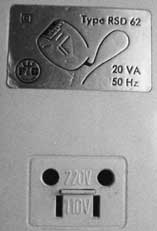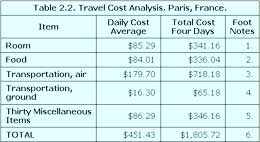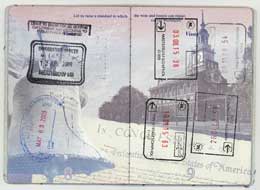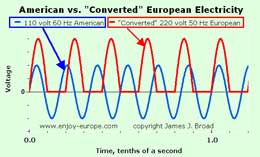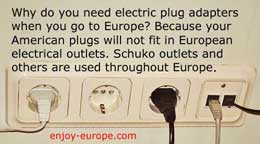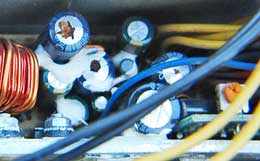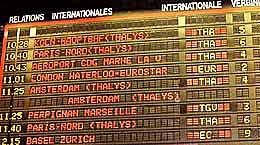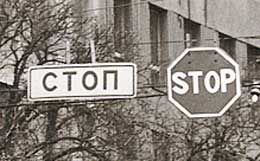European Voltage Essentials
220 Volts of Electric Power at 50 Hz Frequency
Watts, Amps, Volt-Amps, AC, DC, Outlets, Adapters, Converters, and Such
What you see here is the result of plugging a 110 volt computer into a 220 volt outlet. Nevermind that I have been going to Europe for decades, I blew it this time. To be more specific, I blew up the power suppply of my desktop computer. It was a shocking experience, literally. The plug was still a half inch from the socket when sparks started jumping with loud zapps. These zapps were followed by some rather bellicose smoke, producing an extraordinary visual, audio, and olfactory experience.
On opening the cover everything appeared OK. But the guts of the sealed power supply painted a different picture. The tops of three capacitors had their tops blown off. What a mess. White goop had spurted out which quickly hardened to concrete. Good bye power supply.
The takeaway of my misfortune is that travelers must be aware of the higher voltage in Europe and be prepared to deal with it, before it deals with you.
Carpe diem. Vivere bene! Gratia Deo.
This is chapter 11.3. The entire book is published free on-line by the DIY traveler, author, photographer, and webmaster —yours truly— with help from my daughter Stephanie and good friend Paula in Haarlem, Nord Holland, Netherlands. Questions, comments, complaints, and contributions are welcome. Please click footnote. Patronage at my euro-shoppe™ keeps this site on line. Updated .
Don't blow their fuses.
This Internet edition of chapter 11 is presented in three parts:
- 11.1 Electric Converters for Europe: Should I use an electric converter in Europe? No.
- Electric power converters convert 220 volts to 110 volts but do not convert frequency. Converters can destroy your phones, ipads, cameras, computers, and chargers.
- 11.2 Electric Plug Adapters: American plugs do not fit in electric outlets in Europe.
- Even if your gizmo is rated for 220 volts and 50Hz you can not plug it in. American plugs do not fit in any electric outlet in Europe.
- 11.3 European Voltage Essentials: 220 Volts of Electric Power at 50Hz Frequency.
- This is a somewhat technical explanation with photo illustrations of just about everything you need to know. Send an email if you need clarification on anything.
Additional chapters discussing everything from hairblowers to televisions are at:
- 6.2 Personal Care Items for Europe: Pack Your Toothbrush and Toilet Paper
- Most of what you need is in your bathroom right now. But much is handy in Europe. For example, you don't need to bring your hairblower. It is big volume and dead weight.
- 22.1 Moving to Europe?: American appliances may work but probably not.
- Household items to bring and to bring not when you are relocating to Holland, France, Germany, and Switzerland.
CONVERTER MISTAKE
So you want to bring your hair straightener on your trip to Europe, and then you find out that the electricity over there is 220 volts. Of course you probably also want to bring your camera, maybe your phone and laptop computer, and other devices. Attempting to use American 110 volt devices in Europe is a continuing nuisance for travelers.
How do you do that? The popular answer from travel gurus and travel goods suppliers is to bring a converter. This is a mistake which can lead to destruction of anything connected to it and perhaps other things in the neighborhood. Before you go any further please read part 1 of this chapter, An Electric Converter in Europe.
THE DIFFERENCES
For starters, in Europe you will not see the familiar American 2-wire and 3-wire electrical outlets. Instead, there are about a half dozen different styles. Some are obviously distinguishable and some are somewhat similar in outward appearance. That is the initial and obvious issue you must face, the outlet. The American plug on the wire of your gizmos does not fit anywhere in Europe.
Further, there are two hidden and much more serious issues. The voltage is higher and the frequency is lower. This unseen stuff is what shall give a final fatal jolt to your American 120 volt 60 Hz electrical gear. There may be consequential effects, say a loud clanging from the hotel's fire detection system.
These differences create a series of challenges for American travelers using electrical gear in Europe. That would be just about all of us in the 21st century. So follow along here and get up to a first grade level in electrical know-how. First grade is all you need.
This essay is somewhat technical. I have tried to present it in easy language. But if you have any lingering uncertainities please write to me and ask. There are no dumb questions when it comes to safety. I am happy to answer any email on the subject of electricity, and any other travel inquiry if I can. But please, before you write please show some evidence that you have read this entire chapter. I do not write the same stuff twice, despite many emails asking me to do so. See NOTE TO READERS below.
WHAT IS ELECTRICITY?
Electrons
Electricity, in the nearly abstract, is a form of energy consisting of a flow of electrons. What are electrons? Electrons are one of the three basic particles in the universe. Electrons are electrically charged negative pieces of matter and/or energy. Einstein figured that out with his famous equation. Electrons are very mobile. The other two particles are protons and neutrons. Protons are electrically charged positive and neutrons are neutral. Each is about 1,800 times heavier than an electron and do not go anywhere. All of your body parts and totally everything in the universe is made out of these three tiny tiny particles of matter and/or energy. It is amazing what God did.
Electrons flow through wires and provide power to darn near everything. The wire is the path of least resistance. Electrons are dumber than turkeys so that is where they go, normally. However, electrons can be loose canons. They may cut loose and go anywhere. Sometimes they jump out of the wire. This is when you see them, as a spark. When they jump out of a cloud they are known as lightning. Benjamin Franklin taught us that with his kite experiment. Don't try that at home. It should have killed him.
AC/DC
The normal flow of electrons in an electric wire can be continuous in one direction or it can be reversing on a fixed frequency. When it is continuous it is known as direct current, abbreviated as DC. Batteries produce DC electricity. When electricity is of the reversing sort it is alternating current electricity, commonly known as AC. Electricity from a wall outlet is AC.
Measuring the Juice
Electricity is measured in terms of quantity (amperes, amps, A) and force (voltage, volts, V). The energy used is electrical power (watts, W). In household electrical circuits, power is approximately equal to the product of quantity and force. In other words, volts multiplied by amps equals watts. Mathematically that is written VxA=W. Look at the elecrical nameplate of your toaster, for example, do the math, and see if it checks out.
Instead of mentioning watts, the nameplate on many electrical devices uses the term volt-amps, abbreviated VA. The VA is slightly higher than W due to circuit impedance and power factor, stuff you really don't need to know unless you are an electrical engineer.
And instead of mentioning A most electronic gizmos state the quantity as mA. The little m is the abbreviation for milli, 1/1,000 of an amp. So, 500 mA is 500/1,000 amp, half an amp.
Circuit Breakers, Fuses
The quantity of electricity available at any outlet is determined by the size of the wires furnishing it. The fuse or circuit breaker at the main electrical panel is designed to limit the flow of electricity according to the size of the wire. When too much electricity passes through a wire it becomes hot. In the extreme case the wire can become so hot that it melts, starts sparking, and sets the place on fire. Before the wire gets that hot the fuse blows or the circuit breaker opens and prevents damage.
Frequency
The "Hz" you see on electrical appliances indicates the frequency. That is the number of times per second that AC current reverses polarity from negative to positive. It is not an abrupt change. The voltage follows a sine wave, gently rising to a peak and then reversing to a valley. For a visual on this see the graph at An Electric Converter in Europe. In American circuits electricity reverses 60 times per second. The notation for this is 60Hz. European electricity reverses 50 times per second, 50Hz. This is the second major difference between ours and theirs.
Hz is the abbreviation for Hertz, a German physicist long ago.
Electricity in America
Household electricity is normally supplied by your local power company or municipal utility at 110 to 120 volts at a frequency of 60 Hz in the USA. Any device rated between 100 volts and 130 volts works fine. The quantity available in American homes is generally 15 to 20 amps at a single outlet or for the total of all outlets served by a single fused circuit. Thus, one circuit may provide from 1650 to 2400 watts of power. One circuit usually supplies more than one outlet. Many people use a doubler plug or power surge strip so they can use more lights or appliances from a single outlet. This can cause blown fuses.
Instead of fuses, circuit breakers (CBs) are used in most homes built in the last few decades. If the CB for your home office trips often you have too many computers, printers, monitors, and other gizmos plugged into those power surge strips. When I had my old HP III laser printer electricity hog I was tripping the CB so often that it eventually went kaput. Calling in an eletrician to replace the CB cost over $100. Ouch.
European Electricity
The European version of electricity is generally supplied at 220 volts and a frequency of 50 Hz. Officially it is 230 volts plus or minus 10%. Any device rated between 200 volts and 250 volts works fine. Some localities may still have 110 volts but I haven't seen this in many years. A frequency of 50 cycles is the standard frequency regardless of the voltage throughout France, Italy, Germany, England, Spain, and the rest of Europe.
The quantity available, amps, depends on the hotel or home where you are staying. You might be able to use a 1,000 watt hair blower or travel iron. If the lights start to flicker, shut it off immediately. I once blew a fuse in an old French hotel as I was drying my hair with a dual voltage 600 watt hair blower. It seems that Tim Allen has prompted hair dryer makers to boost the power up to 1,875 watts. Vrooom! Vrooooom! This much power would trip a circuit breaker in many hotels. That might be why virtually all European hotels, hostels, B&Bs, and dorms have a hair dryer wired in for each room. If you are making advance reservations ask the hotel if it has hair blowers before you pack your own.
Have a lot of respect for 220 volts. It can easily kill you if you plug the wrong thing into the wall outlet. You might come home as burnt toast.
APPLIANCES
To use electrical appliances in Europe, some hardware is needed in order to plug in without electrocuting your machine, and maybe yourself. Since the hotel keeper or desk clerk probably knows less about electricity than you do, don't bother asking if you can plug in your appliances — you may scare the desk clerk. Just make sure to unplug everything after use. Especially do not leave anything plugged in while you are out sightseeing.
In conjunction with this chapter I urge you to read the ELECTRICAL APPLIANCES section of my chapter 6 part 2, Personal Care Items in Europe: Packing Your Toothbrush and Hair Blower. Chapter 6 has critical information about hair blowers and similar items.
Dual Voltage
While it is feasible to transform European electricity from 220 volts to 110 volts for some appliances, it is safer and far simpler to use dual voltage appliances. Some of these have a 110-220 switch while many are "smart" and can use either voltage with no operator settings to make.
You may not be able to get full power out of a dual voltage item. My hair blower would only go up to the 50% setting at 220 volts, but it worked. A reader has told me that her straightening iron cut out at the half way point also. Neither device was damaged.
Low Wattage Devices
Small 110 volt electrical appliances like radios and razors can normally operate with a 50 watt 220 to 110 volt step down transformer. This is a heavy little package of solid steel plates and copper wires. If your appliance is marked only 60 Hz, and not 50/60 Hz, you run the risk of burning up something inside even when using a 220-110 volt transformer if you use it for an extended period of time.
Laptop Computers, Digital Cameras, Cell Phones, and Similar Devices
These are electronic devices that more and more people are bringing on their trips. I carried four gizmos on my last few trips.
These gizmos are usually powered by custom designed rechargeable batteries. Some of the gizmos work on AA or AAA batteries. Most of the gizmos with rechargeable batteries come with a little black "brick" in the line cord. The brick is a combination transformer and rectifier especially designed to charge the battery for that particular gizmo. The transformer part changes the input voltage to the voltage required by the gizmo's battery. The rectifier part changes the electricity from AC to DC. Batteries operate only on DC. See part 3 of this chapter, European Voltage Essentials: 220 Volts of Power at 50 Hz Frequency for a refresher.
The black bricks always have their electrical specifications embossed or printed on the back side. For example, my Nikon digital camera Quick Charger brick says "Input: 100-240V~50/60Hz 0.18-0.105A 18-25.2VA." The only part of this statement that you really need to know is the part saying Input: 100-240V~50/60Hz. This tells you that it works on both American (110 volt 60 Hz) and European (220 volt 50 Hz) electricity.
If the line cord does not have a black brick then the electrical specifications are printed on the gizmo. You may need a bright light and a magnifying glass to read the small print.
If your gizmo or charger has this Input: 100-240V~50/60Hz electrical specification printed on it then all you need in order to use it in Europe are plug adapter(s) for the countries you are visiting. You do not need a transformer. You do not need a converter. In fact, a converter will probably destroy your gizmo, momentarily light up the room, blow the circuit breaker, and put you in candle mode. You will need to go to the front desk to get your lights working again, assuming that the desk clerk knows how to change a fuse or reset the circuit breaker.
The numbers for A tell you how many amps are used. VA (roughly equivalent to watts, W) tells you how much power is consumed. In the case of my camera battery charger that is in the neighborhood of a 25 watt light bulb. That tells you something else you should be aware of — the brick is going to generate some heat. It won't be much heat but it would be wise to lay the brick out in open air to dissipate the heat and not wrap the brick in a T-shirt where it could get hot.
The bricks for my other three gizmos have similar "Input" statements. The net result is that all I need for powering these gizmos and/or their chargers in Europe is a plug adapter for each one. A plug adapter does not change anything electrically. It only changes the prongs on your plugs. For details of the different plugs in use see the section below on plug adapters.
Frequency Effect
Do not bother bringing a plug-in electric clock or clock radio to Europe. These devices, which generally operate on AC motors, will run at only 5/6 of the speed for which they were designed because the speed is determined by the electric frequency. If you bring your electric alarm clock, assuming that it works on 240 volts, and set it at 6 pm when you check into the hotel, it will read only 11 pm when it is midnight, and only 4 am when it is 6 am. You will probably miss breakfast. You need a battery powered travel alarm.
Your hair blower will run slower, if you set the switch at the 220 volt setting as you should. If your hair blower starts running at a very high speed you have probably plugged in a 110 volt hair dryer or left the switch at 110. If you leave it running on 220 volts it will burn up in a few seconds and your room will smell putrid for a long time.
If your electrical device has a transformer in it, you probably should not bring it to Europe. Lower frequencies require thicker transformers. Transformers designed for 60 Hz operation can overheat and sometimes burn up when used in 50 Hz circuits. Make sure that your stereo receiver is rated for both 50 and 60 cycles before moving it to Europe. We used to have a tape deck which apparently suffered untimely death due to 50 Hz burnout.
Bringing European Appliances to the USA
My web site is all about enjoying Europe. I invite readers to send in any questions they may have about anything to do with their trip to Europe, or moving to Europe. See NOTE TO READERS. I am also getting more questions about bringing European electrical items home to the USA. Can it be done? The answer is maybe, very iffy, probably not. The voltage and frequency are both different.
Voltage can be managed. Using a 110-220 volt step-up transformer is an easy way to boost American voltage to the 220 volts needed by your appliance. See the adverts in the right hand column. Select a transformer that is rated at about twice the watts of your device.
Frequency is a whole different matter. See my chapter 22 Moving to Europe for a discussion of motorized appliances going from the USA to Europe. They run slower over there. Conversely, European 50 Hz motorized devices run faster in the USA. This is generally not good. Potentially it can be rather destructive. Because the motor is going to run 20% faster it will use about 25% more energy. This could burn out the motor windings. Also it will wear out sooner because of the higher speed. You'll probably shorten the life of the bearings and gears by 50%.
Like virtually everything on this web site, I've "been there and done that," including bringing European appliances back to the USA. On moving from Germany back to California we stuffed the car with every appliance that would fit and drove to Elizabeth's sister in Italy. We gave her all the stuff. Then we drove on for our final fling to Istanbul and back to Germany. Of course the refrigerator would not fit in the car. We shipped it to Newport Beach. After two weeks as a back-up refrigerator it died.
TV
If you are relocating to Europe for an extended period, don't bother bringing a TV. Not only because of the differences in electricity, but the broadcast signals in Europe are different. It will not work. An American TV will have a constant roll, snow, and static. We shipped our TV to Germany and that is what happened. See chapter 22, Moving to Europe: International shipping and finding a home in Europe. for more information on television and a hundred other topics.
DVDs
The producers of DVDs have introduced a "zone" system for all DVDs. There are six geographical zones in the world. The USA is #1, Europe and some other areas are #2, etc. DVD players will only play DVDs manufactured for a specific zone. The reason they do this is to control the sales and make more money. Manufacturers do not want "gray market" units floating around and upsetting their sales territories. So if you intend to buy a DVD in Europe make sure that it will play in your zone #1 player, but it probably won't. Or buy a zone #2 DVD player while you are in Europe so you can watch those French movies. But check the electrical nameplate for 110/220 volts and 50/60 Hz. Multi-zone DVD players are available in Europe.
EXCEPTIONS AND CAUTIONS
110/220 Volts
Although European electricity is generally 220 volts, there are a few places where you might find 110 volts. On entering a hotel room, inspect a light bulb. It will be marked with the voltage as at home. Then you know. You can also find the voltage stamped on the back of the radio or TV if your room has one or the other. But there are exceptions. On a visit to Stockholm, I found that the hotel room was 220 volts, except for the shaver outlet in the bathroom. It was 110 volts only. It is more common to find both 110 and 220 volts available in bathroom shaver outlets of the better hotels.
This is a typical electric razor outlet as found in many bathrooms in European hotels. This is a better design than most of them. It has the fat pin Schuko outlet marked 220V and a standard American 110V outlet. Everybody from North America and most of Europe can use this. The British/Irish plug will not fit, of course, and the Italian plug will hang loose. Hanging loose presents a potential sparking problem. Sparks can ignite other stuff and get out of control pretty fast. This outlet only delivers 20 VA (equal to approximately 20 watts) so you won't be able to plug in your hair blower. Get those 1,875 watts somewhere else! This outlet is in my hotel room in Turku (also known as Åbo), Finland (also known as Suomi). I happened upon a statue of Nikolai Lenin in Turku, where he once hid out from the Czar's police.
Old Wires
There may still be a few cheap hotels in Europe warning against the use of any electric appliances in the rooms. Even though some of these places are recommended in popular budget guidebooks, do not stay there. The warning signs in the lobby indicate that the hotel wiring is archaic and that they have had trouble before. Someday some tourist is going to plug in his electrical items and fry the wiring. If you are lucky, all you will lose is the lights. About one hotel in Europe goes up in smoke every year or so. See chapter 14, Hotels, B&Bs, Hostels, Homes: European Travelers' Sleep Options for more information on safety in hotels.
Direct Current Electricity, DC
DC electricity is produced by batteries. DC is used to power cameras, flashlights, camera flash units, portable radios, portable recorders and CDs, calculators, camcorders, laptop computers, etc.. Each appliance has its own unique requirements for batteries. This is stated in the operating instructions and in the battery housing.
It is reported that some parts of Europe are wired for DC electricity in the homes. This is probably a legend from the 19th century. I've been just about everywhere this side of the Dnieper River and I've never seen DC coming out of an electric outlet. But if you find yourself in one of these areas, do not attempt to use AC electrical appliances.
Transformers
Definition: A transformer is a device which can change any alternating current from one voltage to another. The most common transformers are those large gray cans you see mounted on electric power poles in your neighborhood. They convert the high voltage transmission current down to voltage for household use.
Travelers to Europe may need a small transformer to change the 220 volts over there to 110 volts for their American electrical appliances. If your appliances are dual voltage you do not need a transformer.
A 220 volt to 110 volt step down transformer is a heavy little thing because it is made of solid steel plates and two coils of copper wire. Electricity is introduced into the primary coil and comes out at the secondary coil. The change in voltage equals the ratio of the number of turns in each coil. Thus, a 220-110 volt transformer has half as many turns in the secondary coil as in the primary coil.
A transformer can be used to change European electricity from 220 volts to 110 volts so that it can be used in American specification devices. Transformers come in all sizes. The common travelers transformer is 50 watts and can be used for small electrical devices. Larger transformers can be used for bigger devices like kitchen appliances and power tools. Look at the electrical nameplate on your equipment to find out how much power it requires. That is measured in watts. You would only be interested in this if you were moving to Europe. For more information on that subject see Moving to Europe: International shipping and finding a home in Europe. .
This little 50 watt transformer can be used on very low power devices. Because it is made of solid steel and copper it weighs a ton, well actually 10 ounces (300 grams), more than half a pound. Try to avoid the neccessity of carrying around dead weight such as this by using dual voltage travelers' gizmos and appliances. The same item in a different wrapper is #E-070 in the right hand column. For a look inside see the photo labeled Transformer Guts on my page An Electric Converter in Europe.
If you load a transformer to the max wattage on its nameplate it will get hot and maybe start to humm. Get a bigger transformer if it is too hot to hold your hand on it. If you are going to leave your electrical appliances plugged in and running for hours and hours get a transformer rated for at least twice the wattage of your appliances. If you are going to use your appliance for only 10 or 20 minutes you can get by with a transformer rated at the wattage of your appliance.
Some vendors advertise transformers with the added note "for continuous duty" or a similar statement. That is hollow verbiage. ALL transformers can be used continuously if they are operated well below their nameplate capacity. For example, if you have a 500 watt appliance it can run all day from a 1,000 watt transformer. If you ran it from a 500 watt transformer the transformer will get warm, and maybe start to hum. If you ran the 500 watt appliance from a 400 watt transformer you will notice the transformer getting hot and humming loudly. If you run it long enough the insulation will disintegrate and short out the transformer. Sizzle, sizzle, spark, and pop.
Converter
Definition: A "converter" is an electronic device designed to reduce 220 volts to 110 volts. It does this by cutting off half of the sine wave.
Please see the Preface to this chapter at An Electric Converter in Europe.
Batteries
Definition: A battery is an item containing chemicals which react to produce direct current electricity. Dry cell batteries typically produce 1½ volts. They come in various sizes. The most common are identified as AAA, AA, C, and D. The most common wet cell batteries are those used in automobiles. They contain a series of cells filled with extremely hazardous sulfuric acid, lead, and lead oxide. They typically produce 12 volts, in the USA and in Europe, no difference.
Bring spare batteries for your flashlight and gizmos. If you buy batteries in Europe, do not expect much. Cheap off-brands are widely available, and probably dead on arrival when you get back to your hotel room. Even some Duracell batteries I have bought in Europe were completely dead when I tried to use them a few hours after purchase.
Camera batteries are a special subject. See the Camera Batteries section of chapter 12, Photography in Europe: Take Your Best Shot for more information.
Rechargeable Batteries
Definition: A rechargeable battery is one which can be renewed by passing electricity through it by use of a specially designed charger. The chemical reaction which produces electricity is reversed so the battery can be used again and again. Eventually rechargeable batteries wear out and must be replaced.
Nickel metal hydride, Ni-MH, rechargeable batteries made by Sanyo, Eveready, Sony, Panasonic, and others are expensive but pay for themselves in a hurry, especially in Europe. If you are packing anything that uses AA batteries, rechargeables are worth considering.
Battery Charger
Definition: A battery charger is an electronic device which changes wall outlet alternating current to low voltage direct current suited for your rechargeable bateries. The guts of a charger include a transformer to change the voltage and a rectifier to change the AC to DC.
If you are using rechargeable batteries, carry a dual voltage charger. Use a charger made by the same company as your rechargeable batteries. Finding 220 volt chargers in the USA is a problem. Battery chargers rated for 220 volts are available in Europe.
Many cameras use rechargeable batteries. The camera kit always includes a special charger for the battery. These charges are almost always of the dual voltage variety, i.e., 110-240 volts and 50/60 Hz. However some camera battery chargers, especially the older ones, will only work on American electricity. If your charger has only 110 volts and not 110-240 volts on it then the best solution would be to buy a new battery charger, either at your nearest camera store or on line. For further information on this subject see chapter 12 as mentioned above.
Battery Charger Wire
This is something that baffles many people, judging by the email I receive. It also baffles me. For example, the nameplate of my Nikon and my Olympus battery chargers both state "110-240v 50/60Hz." Great. That's just what you need to use the battery charger anywhere in the world, with the appropriate adapter plug of course. But, the wire for each of my chargers has labels attached stating "110 volts" and "USA." Additionally, the special female plug (described as a "figure 8" by one of my correspondents) states "7A 125V." What the heck is going on when you have a 125 volt cord hard wired to a 110-240 volt device. But that's not the end of it. Both of the wires have the following embossed in the plastic insulation, 300v, along with some electro-tech mumbo jumbo. Hey Pavlov, I'm not a dog! I do not understand this, or how something so simple can be so FUBAR. Nevertheless I have used those wires and chargers all over Europe without incident, and I pray that it stays without incident.
SOURCES
Home Town
Individual plug adapters, transformers, and multi-piece kits are sold in some department stores (try the wallet section) and by several electrical specialty companies. Better luggage retailers also carry a selection of electrical devices and other widgets for travelers. Do not be talked into buying a converter. Retail clerks know how to ring up a sale but most do not necessarily know anything about what they are selling.
Airports
The duty free shops in international airports carry many electrical appliances. If you didn't have the opportunity to buy what you need before leaving home, browse through the duty free shop before getting on the plane. When you see the prices you'll wish that you had taken care of this earlier.
After you land in Europe you will again see duty free shops in the airport. But you cannot buy anything in a duty free shop when you land. You can only shop duty free on departure.
Over There
American-to-European plug adapters are nearly impossible to find in Europe so you'd better get these before you go. It is possible to buy transformers in Europe, but it may be difficult to find a small one suitable for traveling. They are also very expensive in Europe. If you really need one, shop in stores selling hardware, electrical goods, computers, or electronics.
The Internet
If you do a search for these electrical devices on the internet you will find
many manufacturers, models, and vendors. I've saved you some trouble by locating
what you need at the Amazon.com store and linking a lot of it on my page at
 Most of these items can be delivered in a few days direct to your door.
Save gas, shop from your computer. Amazon commissions help support this web site
so I can keep it free from pop-ups and other commercial annoyances.
Most of these items can be delivered in a few days direct to your door.
Save gas, shop from your computer. Amazon commissions help support this web site
so I can keep it free from pop-ups and other commercial annoyances.
TRAVELING ELECTRICAL KIT
When bringing electrical appliances to Europe, some or all of the following list must also be carried:
- Plug adapters
- Power surge strip (200-250 volt)
- Transformer
- Converter. Nope, nada, never. See An Electric Converter in Europe.
- Batteries
- Rechargeable batteries
- Battery charger
SUMMARY REFERENCE TABLE
This table answers 99% of the questions I receive. Please have a go at it before you write.
| Your device says: | Action Plan | ||
|---|---|---|---|
|
Volts
See footnote 1. |
Frequency
See footnote 2. |
Watts, Amps
See footnote 3. |
What to do?
See footnote 4. |
| 110 V | 60 Hz |
25 watts or less (¼ amp or less) |
Buy a dual voltage appliance for your trip. Or buy a 50 to 60 watt transformer with European plug. |
| 110 V | 60 Hz |
more than 25 watts (more than ¼ amp) |
Leave your appliance at home and buy a dual voltage item for your trip. Or buy a 220 volt item when you arrive in Europe. |
| 110-220 V | 50/60 Hz |
200 watts or less (2 amps or less) |
Bring your gizmo with a plug adapter or a 250 volt surge strip. |
| 110-220 V | 50/60 Hz |
more than 200 watts (more than 2 amps) |
Bring your gizmo with an individual plug adapter. Do not use a surge strip. |
|
Footnote 1.
Voltages are approximate. 110 volts applies to 100 to 125 volts. 220 volts applies to 200 to 250 volts. Footnote 2. Due to the lower frequency, motorized devices rated for 60 Hz will run at only 5/6 of their normal speed on the 50 Hz of Europe. If European motorized devices designed for 50 Hz are brought to the USA they will run 20% faster and use more watts, for a short while. They will burn out soon after you plug them in. See the Household Items section of chapter 22 Moving to Europe: International shipping and finding a home in Europe. for more information. Footnote 3. Watts and amps are approximate, +/-15%. Footnote 4. NEVER use a converter. |
|||
NOTE TO READERS
I welcome questions and comments. If you have any concerns about your trip to Europe that have not been covered well enough in this section please do not hesitate to write and ask. When you write please include relevant details, per the folowing paragraphs.
ATTENTION, PLEASE!!!
If you are seeking advice on whether or not to use your electrical gizmos in Europe
please send the electrical specifications for your gizmos. This data is on the electrical
nameplate of the gizmo or on the black brick (or white brick if you have an Apple product)
as discussed and illustrated above.
Include the following information in your email:
INPUT
- volts (V or VAC)
- frequency (Hz)
- watts (W) or amps (A) or milliamps (ma) or volt-amps (VA).
If you do not send me this basic information for your specific devices I can not give you any advice. There are a zillion electrical gizmos on the market. I own five of them. I know ABSOLUTELY NOTHING about your tool or toy. I do not have time to look up your gizmo's specifications, and even if I did there is no guarantee that the information I find applies to the thing that you have in your hand. Manufacturers change products by the week. If you do not look at your own gizmo or brick (yes, the information is there) and you do not include the INPUT electrical specifications in your email my reply will be very simple — a reference to this paragraph. I do not want you to fry your computer or other gizmos, not to mention burn down your hotel and go to jail for mischief and manslaughter. Yes, one European hotel burns down just about every year. It's diamonds to dimes that a tourist caused the fire because only tourists stay in hotels. And the major users of "converters" are American tourists because most of the rest of the world already has 220 volt electricity and would never consider using a "converter" — they do not need one.
I do not assume anything. Electricity has no conscience. I am happy to reply personally to everyone who writes and who provides the information that I need in order to respond accurately. Sorry if this sounds a bit harsh. Call it tough love.
I do not open attachments. I do not click links to web pages of any kind. Please include all of the INPUT data from your gizmos in the body of your email as noted above. I will reply in a day or two, usually.
By the way, please do not write and ask what kind of "converter" you should use. I get this question every day.
STOP! STOP! NOW READ THIS.
It is already written on this page and throughout this web site multiple multiple times - - -
<><><> DO NOT USE ANYTHING CALLED A CONVERTER <><><>
.
My email address is electric@enjoy-europe.com.
Have a good trip!
Selections at
#E-010
 3 Pack, Grounded Universal 2 in 1 European Schuko plug adapter.
3 Pack, Grounded Universal 2 in 1 European Schuko plug adapter.
4.8 mm prongs.
Equivalent to type E and F.
You can use this ungrounded Euro plug in many European countries.
#E-020
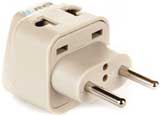 Universal 2 in 1 Plug Adapter
Universal 2 in 1 Plug Adapter
Euro Plug
4.0 mm prongs.
Equivalent to type C.
A universal plug adapter for the UK and Ireland.
#E-030 hhh
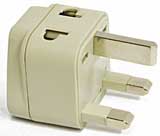 AC Adapter Plug for use in England, Scotland, Wales, and Ireland
AC Adapter Plug for use in England, Scotland, Wales, and Ireland
Equivalent to type G.
Here is the Swiss version.
#E-040
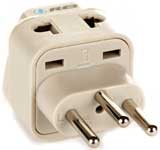 Grounded Universal 2 in 1 Plug Adapter
Grounded Universal 2 in 1 Plug Adapter
Type J for Switzerland
Here is the grounded Italian model.
#E-050
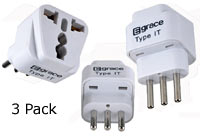 3-Pack. Grounded Universal Travel Plug Adapter for Italy.
3-Pack. Grounded Universal Travel Plug Adapter for Italy.
Type L for Italy
Note: The highlighted #E number is arbitrary. It is meant to help identify products in this advert page when you write in for electrical advice.
This 110-250 volt power surge strip has three universal outlets and an American grounded plug so it needs a plug adapter for the countries you are visiting. Make sure that all your gizmos are rated for 110-240 volts.#E-060
 SM-60 Universal 3 Outlet Power Strip Surge Protector for Worldwide Travel. 110V-250V with Overload Protection.
SM-60 Universal 3 Outlet Power Strip Surge Protector for Worldwide Travel. 110V-250V with Overload Protection.
For charging up to six gizmos at a time use this 250 volt universal power strip. It comes with a grounded Continental plug.
#E-070
 Surge Protector
Surge ProtectorPower Strip
6 Universal Outlets
220/240 Volt 50/60Hz
Most gizmos charge their battery through a USB port so this car charger can keep you going as you drive. European cars have the same nominal 12 volt system as American cars. The LED display on this charger shows the voltage, among other things.
 MONKA@4in1 Dual USB Car Charger
MONKA@4in1 Dual USB Car Charger
This 50 watt transformer changes 220 V electricity to 110 V. It works for small devices up to 35 watts continuous service, if they can operate on 50 Hz which is true for many battery chargers. Check your electrical nameplates and refer to chapter 11.3 for further information.
 50-Watt International Transformer.
50-Watt International Transformer.
Travel Smart by Conair.
For small appliances this transformer will suffice in many cases. It is rated at 200 watts. However, in continuous service it would be best to use it on appliances needing no more than about 100 watts.
 Step Up/Down Transformer
Step Up/Down Transformer
120/240 volt 200 Watt
by Power Bright
Absolutely the best battery for digital cameras which use AA batteries.
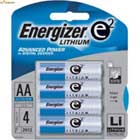 Energizer
EnergizerAA Lithium Batteries
4 Pack
Chapter 1
What's It All About?
Travel Like a Native In EuropeChapter 2, Part 1
On Budget in Europe
Travel Costs: How Much?Chapter 2, Part 2
Europe on WHAT! Per Day?
My Actual ExpensesChapter 3
Passport and Visas
Identity and Travel DocumentsChapter 4
Flying to Europe
Travel Starts at the AirportSection 5
Packing Your Clothes for Europe
A well dressed traveler gets respect everywhere.
Chapter 5
What to Wear in Europe
Your Best Travel Clothesfor All Occasions
Chapter 6 Part 1
Pack Light Field Test
Validating Your Europe Packing ListChapter 6 Part 2
Personal Care Items
Pack Your Toothbrush, Toilet Paper, and Vinegar.Chapter 6 Part 3
Travel Supplies
Small Stuff Packing ListChapter 6 Part 4
Bringing Valuables
Not in Your Luggage or PurseChapter 7
Luggage for Europe
Get Wheels. Let It Roll.Chapter 8 Part 1
Pickpockets in Europe
They're EverywhereChapter 8 Part 2
ATMs in Europe
Machines Dispense Travel CashChapter 8 Part 3
Cash and Credit
Paying Your Way in EuropeChapter 8 Part 4
Money Potpourri
Cash, Coins, Transfer, BarterChapter 9
Your Travel Diary
Blog ItChapter 10
Europe Guide Books
Reviews of Tomes for TravelersChapter 11, Part 1
An Electric Converter in Europe
Electric power converters supposedly change 220 volts to 110 volts.Chapter 11, Part 2
Plug Adapters for European Outlets
American plugs do not fit in any electric power outlet in Europe.Chapter 11, Part 3
European Voltage Essentials
220 Volts of Power 50 Hz Frequency.Chapter 12
Photography in Europe
Take Your Best ShotChapter 13
Bring a Smile
Travel Europe in Good AttitudeChapter 14
Hotels, B&Bs, Hostels, Homes
Travelers' Sleep OptionsChapter 15
Eating In Europe
Travel on Thy BellyChapter 16
City Transport in Europe
Bus, Streetcar, Subway, Taxi, Bike, Shoe, GondolaChapter 17, part 1,
Trains in Europe
A Rail PrimerChapter 17, part 2,
European Rail Stations
Finding Your WayChapter 17, part 3,
Night Trains in Europe
Sleeping City to CityChapter 17, part 4,
Boat and Bus Services
High Seas Ferry, Highway CoachChapter 18, part 1
European Auto Rental
Details and DocumentationChapter 18, part 2
Driving in Europe
Back Alley to Blazing AutobahnChapter 18, part 3
Driving Habits and Laws
Police, Speed Limits, TailgatersFor all 30 chapters and much more see
HOW TO EUROPE
The Complete Travelers HandbookFree to use but not to abuse.
Copyright:
Internet edition
© 2001-2017 James J. Broad
All rights reserved. Tous droits réservés.
This is copyrighted material. Do not reproduce, copy, plagiarize, re-craft,
store, modify, extract, transmit, or purloin any part of this
publication in any nation in any form or by any means or for any purpose whatsoever without permission
in writing.
Copying:
You may print one paper copy of this web page for your personal use.
Permissions:
If you want to adapt any part of this material to use in your blog, forum, web site, book, article,
speech, term paper, movie, video, or any other media please write to me and get
permission before you do so. Otherwise it is a copyright violation or plagiarism.
Plagiarism includes paraphrasing text and copying ideas. Imitation,
the old saying goes, may be the highest form of flattery. However, plagiarism is outright theft and is usually
compounded by the lies of the perpetrator.
Everything on my web site is original, created at great personal expense
in time and cash in the course of my extensive travels throughout Europe. Please respect my property.
For detailed descriptions of the many forms of plagiarism see
Plagiarism.org and
A Plagiarism Guide for Students.
For permission to use material from this web page contact:
electric@enjoy-europe.com.
Webmasters:
You may link the URL http://www.enjoy-europe.com/european-voltage.htm freely. Please do. When you link please send the URL for your linking page and a crosslink will be installed in one of the categories of the TRAVELERS YELLOW PAGES to your site if it has significant content for travelers in Europe.
Free, free, and free
This web site is totally free for everyone, and a labor of love for me.
Support
To keep enjoy-europe.com afloat I advertise scores of travel related books and products. My site receives a commission from Amazon.com for all goods purchased through the advert links. These advert links are displayed on individual pages and on my on-line store at
 . Your support is most gratefully appreciated. TIA.
. Your support is most gratefully appreciated. TIA.
Your Blow Back
I welcome questions, comments, and complaints. If you have any concerns about your trip to Europe that have not been covered well enough on my web site please do not hesitate to write. Ask, cuss, discuss, or whatever. I read every email and update my pages when I see a question repeating,
Utilities:
- How To Europe: The Complete Travelers Handbook.
- Home.
- To the top of this page
- E-Mail to John Bermont
- Meet the Author
- Privacy Policy
- Site Map
- Advertising Policy



